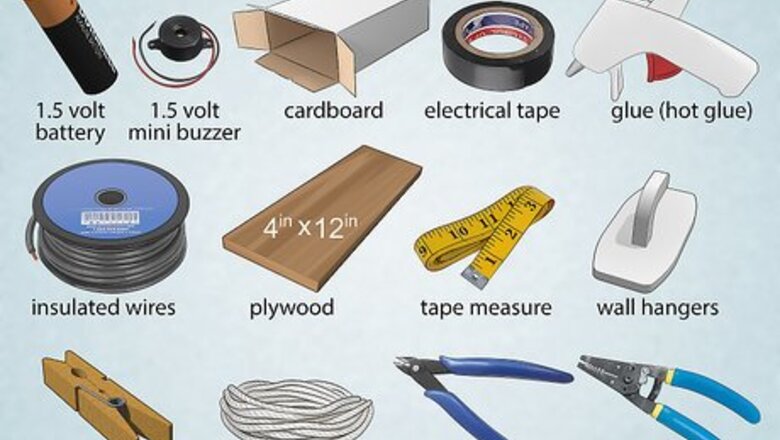
views
Readying to Build and Mount Your Alarm
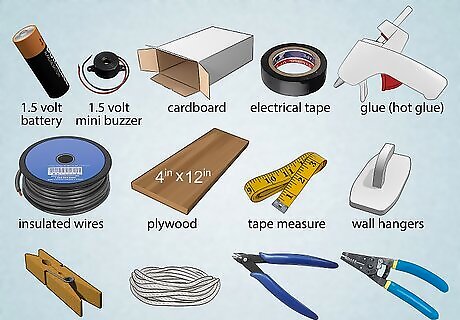
Gather your materials. The supplies you need should all be available at your local hardware store or home center. If a 1.5 volt buzzer isn't available at your local hardware or home center, try looking at an electronics store. All things considered, these supplies should cost around $30 if you have to buy all of the following: 1.5 volt battery 1.5 volt mini buzzer Cardboard (like from a cereal box) Electrical tape Glue Insulated wire (3 strands, small gauge) Piece of plywood (4x12 in (10.2x30.5 cm) or larger) Tape measure (or measuring stick) Wall hangers (glue-based, removable) Wooden clothespin (with spring) 3 - 5 ft (.91 - 1.5 m) of string Wire snips (or sturdy scissors) Wire strippers
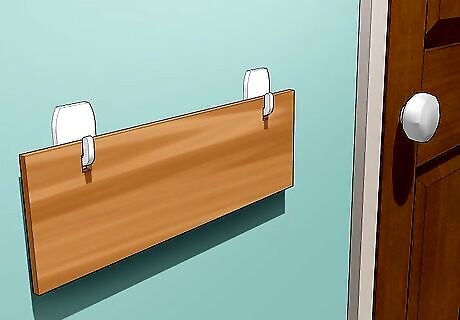
Attach the plywood to the wall next to your door. Use removable wall hangers or tape to attach the wood on the wall. This will be the base of your door alarm. You may need to drill holes in the wood to hang it from the hangers. Generally, you'll want to attach your piece of wood close to the top of the door, within a foot (30.5 cm) from the door frame. Alternatively, you can place the alarm flat on a desk, nightstand, or bookshelf positioned close to the door so you don't have to hang it. An alarm that's high up will be harder to reach and deactivate. Doing this, however, might require more string.
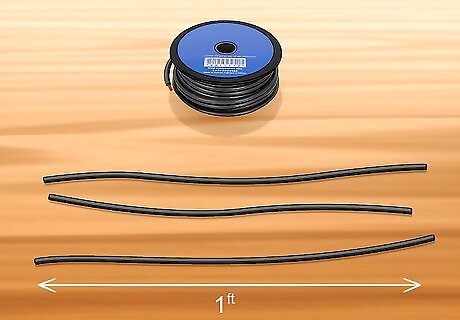
Cut three strands of insulated wire. Use a pair of sturdy scissors or wire snips to cut three stands of wire each one foot (30.5 cm) long. If using scissors, you may have to work these back and forth before the wire weakens and cuts. Measure the wires with a tape measure or measuring stick and bend the wires where you will cut them. This will make it easier to cut accurately. If you find that your scissors don't cut the wire well, a sharp knife, like a utility knife, can work as a substitute.
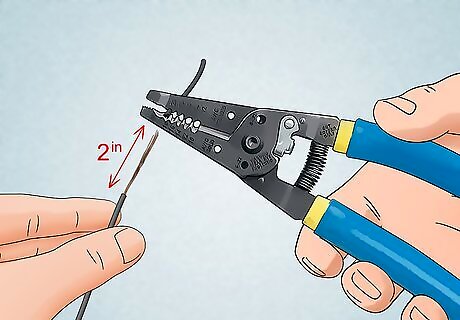
Strip the ends of each strand. Each wire should be covered in an insulated coating. This can be stripped off with your wire strippers. Place two inches (5 cm) of wire into the slot on the strippers that is marked for the gauge of wire you are using. Close the strippers firmly and pull the wire through to remove the insulation. Do this for both ends of each strand. Scissors or a utility knife can also be used to remove insulation. Cut the insulation until you hit the metal wire on the inside, then peel off the insulation. If the insulation doesn't come free easily, use a pair of pliers to grip the insulation firmly and pull it off.
Building the Alarm
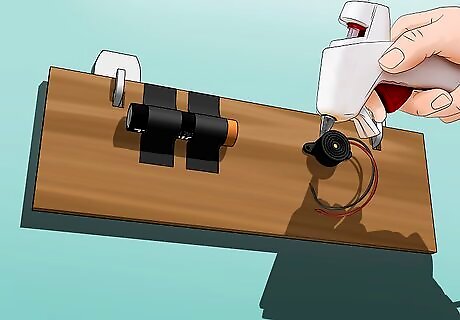
Tape the battery and buzzer onto your wooden board. Use electrical tape to attach these to the wood. The tape should not interfere with or cover any of the connections for the electrical circuit for the buzzer, nor should it cover the positive (+) or negative (-) ends of the battery. Your buzzer may come with screw holes. For a sturdier alarm, you can screw your buzzer into the wood. Be careful to use short nails so these don't protrude through the board.
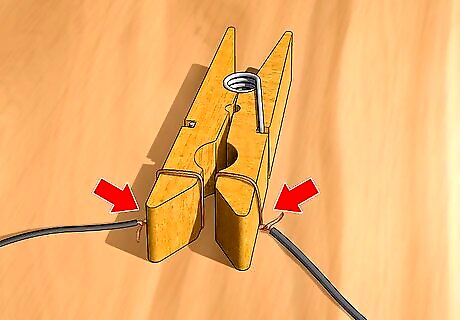
Wrap the stripped wire around the ends of the clothespin. Wrap one stripped end of two pieces of wire around frontmost divot of the top of the clip-end of the clothespin. Do the same to the bottom of the clip-end of the pin with a separate wire. Twist the stripped wires around the pin until they are tight. When the pin closes, the wires should touch. This will complete the circuit that sets off your alarm.
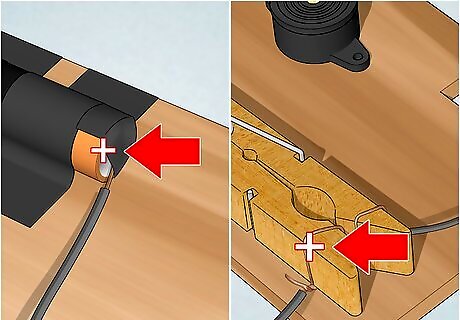
Connect the bottom-pin wire to the battery. Position the wire so it is directly touching the positive (+) end of the battery. Use a piece of electrical tape to fasten the wire in place. If your battery is in a dock or cradle, attach the wire to the positive connector or wire for the cradle and tape it in place.
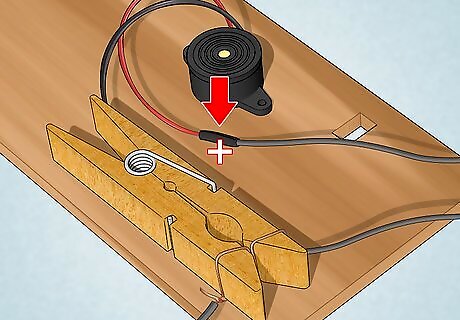
Connect one non-battery wire to the buzzer. There should be a small opening in the buzzer where you can insert your wire. There should be two connectors, positive and negative. Touch one of your top clothespin wires directly to the positive input for the buzzer. Alternatively, your buzzer may have wire leads coming off of it. Strip these, if necessary, and twist your non-battery wire to the positive buzzer wire.
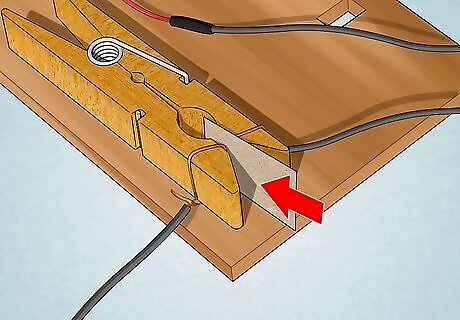
Break the circuit with a piece of cardboard. Cut a medium sized piece of cardboard to insert between the wires wrapped around the clothespin. Insert the cardboard so that the wires on the clothespin do not touch when it is closed. This will stop the buzzer from going off. Any non-conductive material will work to break your circuit. Try small pieces of paper, wood, or rubber. You may need to fold thin cardboard so there is more distance between wires. Very thin cardboard may not reliably keep the circuit broken.
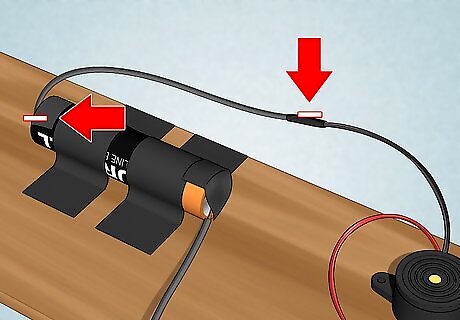
Connect the remaining wires. Attach the stripped end of one of your remaining free clothespin wires to the negative (-) end of the battery. Fasten it with electrical tape. Then, in the same fashion as the first, attached the final clothespin wire to the negative (-) input for the buzzer. After you finish attaching the wire to the buzzer, cover any remaining bare wires with tape. While the circuit is engaged, touching bare wire will result in a shock. Be careful not to knock out the circuit breaker between the wires of your clothespin. Doing so will complete the circuit, and likely cause a small shock when you try to attach the wire to the buzzer.
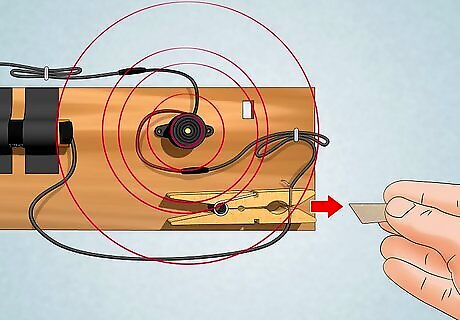
Test the switch by completing the circuit. Lay your alarm on a flat surface. Open the clothespin and remove the circuit breaker (piece of cardboard). When the clothespin closes, the circuit should complete and the buzzer turn on. The ends of stripped wire on the clothespin should be in good contact. If they aren't or are just barely touching, wrap more wire around the clothespin. When adjusting the clothespin wires, disengage your battery from the circuit to prevent getting shocked.
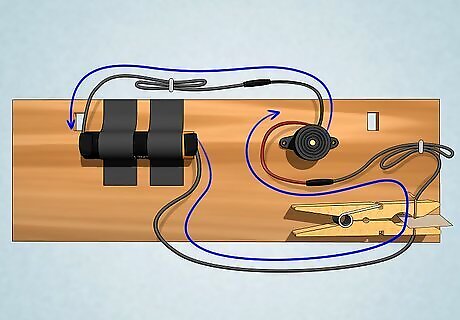
Check connections and the battery if the buzzer doesn't activate. If the buzzer doesn't activate, one of the connections is likely loose. Reinsert the breaker (cardboard) and refasten all connections. After that, if the alarm still doesn't work, replace your current battery with a new one. To improve connections between wires, wrap wires together. After that, tape bare wires to prevent accidental shocks. To improve the connection between connectors, use pliers to coil the end of the wire in a small circle. The circle should be small enough to fit against the connector. Tape the wire circle to the connector. In some cases, you may have a faulty buzzer. Test your buzzer by hooking it up to a traditional power source as directed in the buzzer directions. If it doesn't work, your buzzer is faulty.
Installing the Alarm
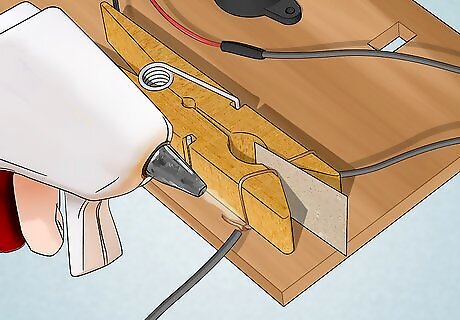
Glue the clothespin to the board. Remove your board from the wall. Your battery and buzzer should already be taped to it. Glue the clothespin so it is positioned somewhat close to the battery and buzzer. Follow the glue directions and allow the glue to dry completely before moving on. A clothespin is small enough that general purpose glue or hot glue should work to fasten it. For best results, you may want to use a sturdy glue or a wood glue.
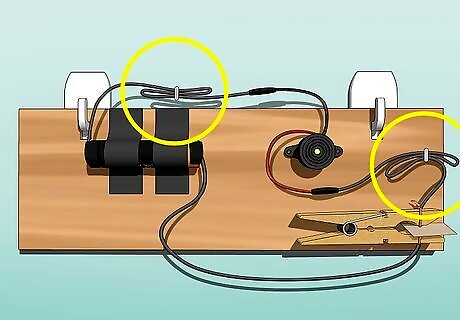
Manage excess wires with tape and hang the board. Wires sticking out in all directions can be a hazard. They can snag on objects or be easily pulled out. Damaged wires will deactivate your alarm. Tape your wires to the board to prevent them from snagging or being pulled out. Then re-hang the board on the wall.
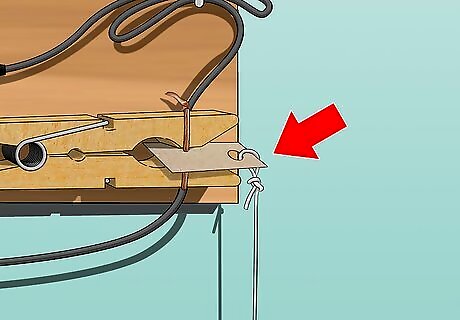
Attach the string to the piece of cardboard in the clothespin. Tape a piece of string to the cardboard. Alternatively, use scissors to make a small hole in the cardboard and tie the string to the hole in the cardboard in a simple knot. Make sure the string is firmly attached to the cardboard. The door may be opened suddenly. If weakly fastened, the string may pull free while the cardboard remains. In this case, the alarm will not go off.
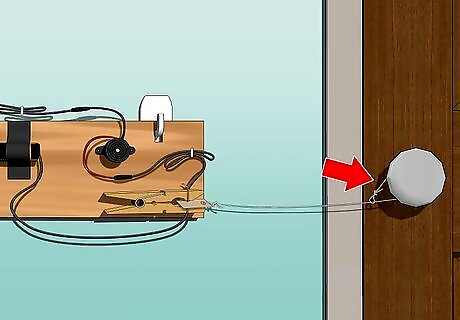
Fasten the other end of the string to your door. Attach the string to the doorknob or tape it to a part of the door. Adjust the length of the string so that when the door opens, the string is pulled. When the cardboard pulls out, the alarm will go off. If your door is painted or made of a nice material, you may not want to tape the string to it. Some tape, when peeled away, can damage paint or wood.
















Comments
0 comment